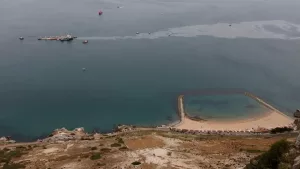LNG Carrier Survives Collision
A bulk carrier of 35,400 dwt collided with a 162,000 cbm and 289 meters long LNG tanker off Gibraltar last August .The LNG vessel is owned by an Omani company and flagged in the Marshall Island.The bulk carrier was beached on a sandy seabed at 17 m depth .The damage caused to the LNG carrier , typically double hulled, was its bulbous bow reportedly being damaged.
What is of concern is that the ship was carrying 183 tonnes of heavy fuel oil, 250 tonnes of diesel and also lube oil and major ecological damage may take place. The beaches of the Spanish town of La Línea de la Concepción witnessed oil slicks from the beached bulker.
 Credit BBC Reuters
Credit BBC Reuters
LNG and Mounting Environmental Concerns
Liquified Natural Gas is cryogenic and maintained at -162 C and in this case the bulker was the casualty of the collision. LNG vaporises when exposed to the atmosphere whereas crude is viscous and sinks and its cleaning operation is cumbersome.The flash point of petrol and diesel is low and these fuels are highly inflammable .Efforts to repair the hull were unsuccessful and it broke and fuel leaked into the sea from the bulkers vents and marine species such as limpets , seabirds and cormorants are likely to be affected . Heavy fuel spilled in patches and with the spill becoming viscous the marine ecosystem may be seriously damaged. The relevant authorities in the Bay deployed booms and skimmers to contain and recover spilled and leaked oil in the Bay of Algeciras in Spain. On account of the sheer size and volumes of LNG cargoes increased traffic of LNG across seas can result in more serious collisions. It seems marine conservation has taken a back seat in the frenzy to ship LNG from energy producers to consumers with scant regard to environmental disasters that may occur.

Leave A Comment